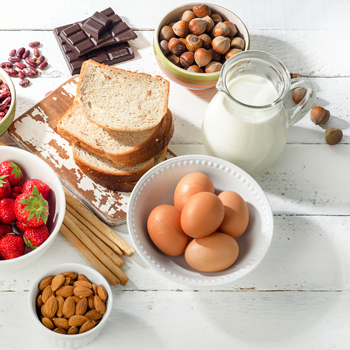งานแสดงสินค้า ครั้งสำคัญของวงการอุตสาหกรรมอาหารและเครื่องดื่ม ที่รวมสุดยอด 11 งานแสดงที่เกี่ยวข้องไว้ใต้หลังคาเดียวอย่างยิ่งใหญ่
งานแสดงที่น่าสนใจและสร้างความประทับใจแก่ผู้มาเยือนในทุกครั้ง THAIFEX-World of Food Asia จะจัดขึ้นอีกครั้งเป็นครั้งที่ 16 ในระหว่างวันที่ 28 พฤษภาคมถึงวันที่ 1 มิถุนายน 2562 เพื่อจัดแสดงสินค้าเกี่ยวกับอุตสาหกรรมอาหารและเครื่องดื่ม (F&B) ที่รวบรวมที่สุดของอุตสาหกรรมไว้ในงานนี้งานเดียว งานนี้ถือเป็นงานแสดงสินค้าด้านอาหารและเครื่องดื่มที่ใหญ่ที่สุดในภูมิภาค เปรียบเสมือนประตูทางยุทธศาสตร์ที่สำคัญสำหรับภาคธุรกิจ และบริษัทต่าง ๆ ที่ต้องการเจาะตลาดในภูมิภาคอาเซียนและอินโดจีน
ยกระดับประสบการณ์งานแสดงสินค้าครั้งสำคัญ
ในฐานะงานแสดงสินค้าที่มุ่งสู่การอำนวยความสะดวกทางธุรกิจ ทั้งยังนำไปสู่ข้อตกลงทางการค้าที่มีคุณภาพ THAIFEX-World of Food Asia 2019 จะนำเสนอประสบการณ์ใหม่สำหรับกลุ่มผู้ซื้อหลัก ซึ่งกิจกรรมสำหรับกลุ่มผู้ซื้อหลักได้รับความนิยมเป็นอย่างมากในปี 2561 โดยมีกลุ่มผู้ซื้อต่างประเทศหลักจาก 2,168 รายเข้าร่วมงาน โดยในปีนี้กลุ่มผู้ซื้อหลักจะสามารถเลือกผู้แสดงสินค้าที่พวกเขาต้องการพบได้ล่วงหน้า เพื่อให้แน่ใจว่าการนัดหมายในช่วงวันแสดงจะมีประสิทธิผลและมีความหมายต่อพวกเขาอย่างแท้จริง
ในครั้งนี้จะมีบัตร THAFEXclusive บัตรสมาชิกสุดเอ็กซ์คลูซีฟ ที่จะออกให้สำหรับผู้ซื้อชั้นนำเพื่อการเข้าถึงงานแสดงที่รวดเร็ว พร้อมมอบสิทธิประโยชน์พิเศษอื่นๆ เช่น เครื่องดื่มและอาหารรับรอง บริการเจ้าหน้าที่ให้ความอำนวยความสะดวก การเข้าถึง WIFI บริการนวด รวมถึงบริการรับฝากและเก็บรักษาสัมภาระ
และเพื่อให้ธุรกิจสามารถเพิ่มประสิทธิภาพและผลกำไรได้อย่างเต็มที่ อิมแพ็คชาเลนเจอร์ฮอลล์ 1 ได้รับการปรับแต่งใหม่ให้เป็นโถงแห่งเทคโนโลยีซึ่ง บริษัทต่าง ๆ ใน 3 กลุ่มเทคโนโลยีของ THAIFEX – ประกอบด้วย เทคโนโลยีอาหาร บริการอาหาร และกาแฟและชา จะจัดแสดงผลิตภัณฑ์ชั้นนำของพวกเขา รวมถึงเครื่องมือและกระบวนการต่าง ๆ
A highly engaging and multi-sensory show, THAIFEX-World of Food Asia returns for its 16th edition from 28 May to 01 June 2019 to serve up the best of the food and beverage (F&B) industry in one blockbuster seating. The region’s largest dedicated F&B trade show is the strategic gateway for companies looking to penetrate the industry in the ASEAN and Indochina regions.
An Elevated Tradeshow Experience
As a show geared towards the facilitation of quality business and trade deals, THAIFEX-World of Food Asia 2019 will feature a new and improved hosted buyer experience. The hosted buyer program was a huge hit in 2018, with 2,168 hosted international buyers attending the show. This year, hosted buyers will be able to pre-select the exhibitors they want to meet ahead of time to ensure that appointments during the show days are productive and meaningful.
An exclusive membership card, the THAFEXclusive Card, will be issued to top buyers for quick access to the show with exclusive benefits such as complimentary F&B, concierge services, WIFI access, massage as well as luggage delivery and storage.
To allow businesses to increase efficiency and profitability, IMPACT Challenger, Hall 1 has been re-tailored as the Technology Hall, where companies across 3 technology sectors of THAIFEX – Food Technology, Food Service and Coffee & Tea – will be showcasing their leading products, tools and processes.









